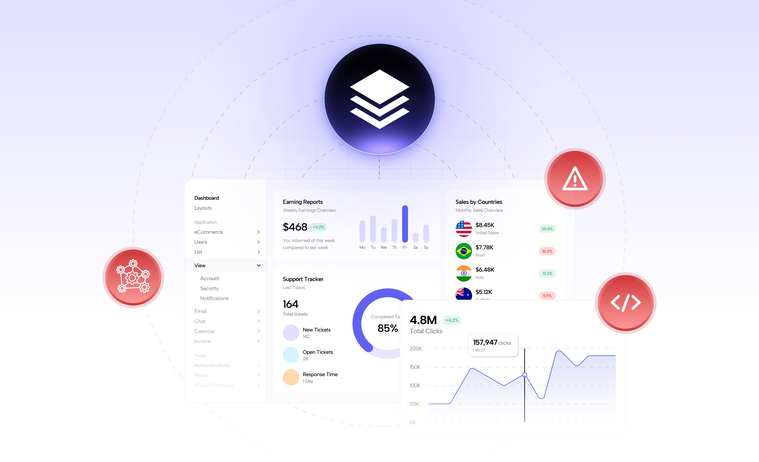Top Mistakes Made While Embedding Customer-Facing Analytics
As SaaS companies prioritize user experience and insights to gain an edge over the competition, providing users with in-product analytics has become a crucial differentiator. Whether it’s a dashboard displaying campaign metrics, product revenue, or average ticket response times, users now anticipate having their data directly visible within the products they utilize.
However, embedding this capability into products is far more complex than it first appears. Building customer-facing analytics involves much more than just building a few data connectors.
In this post, we’ll explore the most common mistakes SaaS teams make when embedding SaaS analytics and show how a tool like Embedded Peaka helps you avoid them.
1. Underestimating the technical complexity
The most common mistake in embedding customer analytics is to think that connectors and a frontend charting library can suffice. The reality is different, however. For a reliable embedded analytics experience, a data stack should include
-
Connector infrastructure for third-party systems (e.g., CRMs, payment processing platforms, SaaS tools),
-
A federated query engine,
-
A UI layer with editable queries, previews, and browser components,
-
OAuth flows, retry logic, and rate-limit management,
-
Security, governance, and multitenant data isolation.
Most of the time, teams are forced to work with a patchwork of open-source and custom tools to build a functioning embedded analytics infrastructure. But, the hassle of maintaining brittle pipelines renders this effort unsustainable over the long term, making the team look for alternatives or give up altogether.
2. Over-reliance on data replication
Another common blunder in embedding customer analytics is to resort to extensive data replication. Copying and moving data into a data warehouse to make it searchable may sound sensible at first, but it comes with problems:
-
Latency: Copying and moving data takes time, which makes real-time analytics impossible.
-
Data security: Copying sensitive data creates security risks and may violate certain regulations.
-
Cost: Data replication creates demand for storage and compute power, which costs money.
Innovative SaaS companies overcome these problems with federated querying, which allows them to access data in real-time with zero-copy.
3. Overlooking multitenancy and access controls
A SaaS platform’s success can also become its bane if its infrastructure fails to scale as needed. This happens when teams try to add multitenancy to an analytics layer that was initially configured to handle a single-tenant model. As a result, it becomes a nightmare to
-
Manage access permissions,
-
Mitigate data exposure to unauthorized users,
-
Streamline the conditional logic across dashboards.
Multitenancy should not be treated as an afterthought; it must be integrated into an analytics platform to provide a personalized analytics experience for each user.
4. Ignoring the frontend experience
Technical teams can become occupied by backend tasks and ignore the user experience offered by platforms. However, considering that it will be mostly business teams using the embedded customer-facing analytics, an easy-to-use, intuitive UI is just as important as a platform’s technical capabilities.
For an embedded SaaS analytics experience, teams must build
-
Connector dialogs and data browsers,
-
SQL editors with autocomplete,
-
Customizable themes.
Building all these adds weeks, if not months, to a product team’s roadmap, forcing them to make difficult decisions.
5. Delaying OAuth and compliance planning
Certain tasks critical for data security, such as OAuth flows, access tokens, and audit logging, are only addressed at the end of the development cycle, which makes them blockers during that final stage. But a sloppy job in those areas will lead to
-
Possible data breaches,
-
A risk to reputation, loss of business opportunities, and potential legal responsibility,
-
Delays in roadmap targets.
SaaS companies need to either develop these security features in-house by allocating more resources or deploy embedded analytics tools that come equipped with them.
6. Trying to reinvent the wheel
One of the most serious mistakes teams make while building embedded analytics capability is trying to build the whole data delivery stack in-house. Instead of incorporating what embedded platforms already offer, engineers spend months developing
-
Connector infrastructure,
-
Caching and rate-limit handling,
-
Federated SQL query engine,
-
Customizable embedded UI components.
All of these items are doable, but offering customer-facing analytics shouldn’t come at the cost of stalled product development in core areas.
How does Embedded Peaka help minimize these mistakes?
Being a full-stack, white-labeled data integration and delivery platform, Embedded Peaka is purpose-built to tackle the pitfalls listed above, as it
Simplifies technical complexity: With no connectors to build, no data warehouse to manage, and no frontend UI to develop, Peaka significantly simplifies the complexity that product teams face.
Eliminates data replication: Peaka uses data virtualization to unify data without the need to copy and move data to a central repository. It leverages caching on Iceberg to offer an optimal blend of speed and cost and ensures that product teams can deliver customer-facing analytics in real-time, without incurring high costs and compromising data security.
Provides built-in multitenant access control: Product teams typically spend months developing multitenant access controls. These controls are already built into Embedded Peaka with its project-catalog-schema hierarchy and granular access controls. As a result, each user (tenant) can access customized analytics dashboards securely and keep their data isolated from unauthorized access.
Fasttracks frontend development: An intuitive UI is an integral part of the embedded analytics experience. However, developing connector dialogs, SQL editors, and customizable theming severely brings down product velocity. Peaka’s embeddable UI with full white-labeling and branding support gives SaaS product teams a head start in creating a branded analytics experience without building a frontend from scratch.
Ensures data security and regulatory compliance: Developing scalable OAuth flows, audit logging, and lineage tracking can slow down integrations and feature delivery, leading product teams to overlook them until they no longer can. Peaka’s audit logging and lineage tracking provide the visibility necessary for regulatory compliance while giving teams the option to choose from a bring-your-own keys or Peaka-managed OAuth model.
Offers a complete data management solution: In addition to serving as a data management backend, Peaka can be used as a complete data management solution that includes an embeddable UI, giving product teams exactly what they need to accelerate product development like no other product in the market can.
Conclusion
Offering in-product analytics requires going beyond data integration and embracing a new approach that treats data as a product. Teams that can make this transition successfully can implement embedded SaaS product analytics and create a smooth user experience with built-in scalability and governance.
Are you tired of dealing with backend complexity? Do you lack the resources to develop frontend features from scratch? It might be time to look at a purpose-built solution like Embedded Peaka. Let Embedded Peaka simplify the technical complexity for customer-facing analytics while you focus on growing your business.
Schedule a demo and see how easy it is to embed BI into your SaaS product.
Make sure to check out our blog post for step-by-step instructions on how to build a churn analysis dashboard in one hour.




 Please
fill out this field
Please
fill out this field










